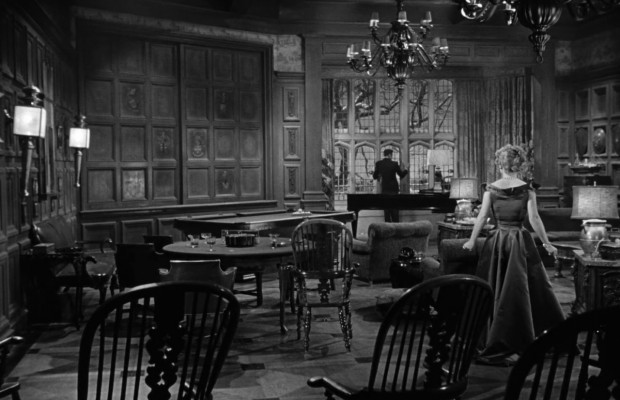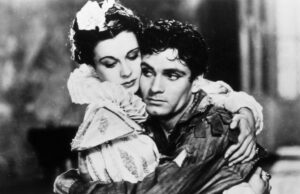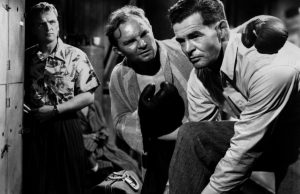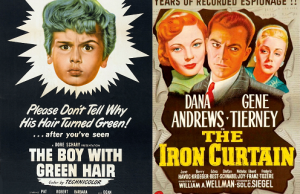Caught (1949)
By Toronto Film Society on April 5, 2016
Toronto Film Society presented Caught (1949) on Monday, April 4, 2016 in a double bill with My Cousin Rachel as part of the Season 68 Monday Evening Film Buff Series, Programme 7.
An Enterprise production released by MGM. Producer: Wolfgang Reinhardt. Director: Max Ophűls. Screenplay: Arthur Laurents—from the novel “Wild Calendar” by Libbie Block. Director of Photography: Lee Garmes. Music: Frederich Hollaender. Editor: Robert Parrish.
Cast: James Mason (Larry Quinada), Barbara Bel Geddes (Leonora Ohlrig), Robert Ryan (Smith Ohlrig), Frank Ferguson (Dr. Hoffman), Curt Bois (Franzi), Ruth Brady (Maxine), Natalie Shaefer (Dorothy Dale), Art Smith (Psychiatrist), Sonia Darrin (Miss Chambers), Bernadine Hayes (Mrs. Rudecki), Ann Morrison (Miss Murray), Wilton Graff (Gentry), Jim Hawkins (Kevin), Vicki Raw Stiener (Lorraine).
This is a dull film for anybody. It will be particularly depressing to women who have come to regard an annual vicarious beating from Mr. Mason as essential to a full and happy life. – Daily Express
At moments a faint suggestion of Citizen Kane stirs in the sets of magnificence and megalomania, but it dies away, and little, save conventional melodrama, is left. – The Times
Somewhere along the way (James) decided he could play the part of a kind and gentle doctor. Of course he can’t. Every time he appears with the girl (Barbara Bel Geddes) she steals a scene from him, and every time he appears with the brutal husband (Robert Ryan) he steals one too. In fact, the only time poor James is safe on the screen is when he is by himself. And even then he isn’t very interesting. Nevertheless…it is quite the best made bad story I ever remember seeing –Daily Herald
This little-publicised movie was a financial failure, but I think it is the most interesting and emotionally complex of Ophűls’s American pictures. – Pauline Kael, Kiss Kiss, Bang Bang
The film was accorded a ‘Sneak Preview’ in Pasadena, an area where wealthy people reside. The ‘cards’ were the greatest the theatre manager had ever seen. The cards referred to, circulated among the audience, contained a brief questionnaire, the answers to which were supposed to show how the big public might be expected to respond at the time of the film’s release. Enterprise, the company that made Caught, were so delighted by the Pasadena reception that they saw no point in exposing it to further preview adjudications, although the release date was three months ahead. For everyone concerned with the making of the film these were three months of euphoria, a great time for signing contracts with an upping of salaries. Things returned to normal when the film opened in New York. No-one came to see it. – James Mason (1974)
The Films of James Mason by Clive Hirschhorn with some second thoughts by James Mason (1975)
Born in Saarbrűcken, Germany, in 1902 as Maximillian Oppenheimer, the filmmaker known as Max Ophűls was the son of Jewish textile merchants. He decided as a teenager to pursue the theatrical arts. At first merely an unsuccessful actor, Ophűls then directed his first play at age 21, sparking a career that led to the Vienna theatre world, where he embarked on a career-long symbiotic relationship with playwright Arthur Schnitzler. In the early 1930s, Ophűls moved to UFA, the German film studio in Berlin, where he first apprenticed under Anatole Litvak. Later in the 1930s, Ophűls directed films throughout Europe, settling in France in 1938. In an all-too-common German-Jewish exile’s tale of that ill-fated decade, and as German military aggression mounted, Ophűls fled first to Switzerland and then to Hollywood. From 1941 to 1947, Ophűls found few defenders of his artistic mastery of mise-en-scène and the German flowing camera for which he is now famous. Finally, in 1947, Robert Siodmak was able to ensure that Ophűls, in the span of twenty-four months, made three exquisite, though financially unsuccessful American melodramas—Letter from an Unknown Woman (1948), Caught (1949), and The Reckless Moment (1949). Afterward, Ophűls returned to France where he completed a string of international art house masterpieces, including La Ronde (1950), an adaptation of Schnitzler’s play; Le Plaisir (1952), an omnibus film of Guy de Maupassant short story adaptations; [The Earrings of Madame de… (1953);] and Lola Montès (1955), a grandiose colour film shot in widescreen Cinemascope. The film stands as one of the great monuments to art cinema, but was a commercial failure at the box office. Deeply wounded, Ophűls retreated to the theatre, and died of heart failure in Hamburg, Germany in 1957 without having completed another film. — by Walter Metz
Fifty Hollywood Directors; edited by Yvonne Tasker and Suzanne Leonard (2015)
It is hardly possible nowadays to see Max Ophűls’s Caught without pondering the muddled legends on how it was made—and why. On the one hand, you have this begging romance about a rather easygoing (empty-headed) model named Leonora Eames (Barbara Bel Geddes), her gaze full of those silly, romantic dreams that afflict women, who finds herself not just wooed by but married to Smith Ohlrig (Robert Ryan), a millionaire without feeling, the kind of husband who behaves in such a way that the wife is going to wonder whether he’s just “Oil rig” misspelled. So she can’t take the misery any longer, and she runs away and finds a job as receptionist at the clinic of a small, hardworking medical partnership—half of which is Dr. Larry Quinada, all of whom is James Mason—in a poor neighborhood, where the dedicated docs work late. And this girl never even pauses to ask, is she lucky or what?
On the other hand, the film apparently grew out of Ophűls’s pathological loathing of Howard Hughes, a lifetime’s experience acquired on the wretched Vendetta project. Thus, Ophűls approaches the screenwriter, Arthur Laurents, and tells him, Don’t bother too much with the book you’ve been assigned (“Wild Calendar”, by Libbie Block); make this film the blackest portrait you can of that evil Howard Hughes! Well, why not? So many films have been made by great or graceless men attempting to portray their own story, why not a piece of character assassination like this? Except that word gets back to Hughes himself—the walls have ears, et cetera—and Hughes, in a passing whit of flimsy, calls in Robert Ryan and says I hear you’re playing me—in which case, let me give you a few pointers.
Of course, what we’re outlining here is the picture of a world so demented that it passes understanding that it should be taught at decent universities, let alone that Ph.D.’s should be given for advanced knowledge in it. Something else remains to be said: Caught is a treat. Somehow all the mixed motives have conspired to make a love story noir in which the rawness of the material makes a rich contrast with the sophistication and warmth in Ophűls’s way of looking at people.
Arthur Laurents is on record as saying that he couldn’t see what the fuss was about where Ophűls was concerned. In which case he should look more closely at the rapturous passage of the film where Leonora joins the Quinada practice—look at the spaces. The light, the movement of the camera (there is a dance sequence that is ravishing), and the overall way in which Mason (who loved Ophűls) begins to convey to Leonora that she is in another world.
Photographed by Lee Garmes, Caught has passages where the cinematic density lifts the whole project up. There is also music by Frederick Hollander. To my eyes, Robert Ryan is just like Robert Ryan in a rather clichéd role, but Mason is the heart of the film. Good support from Curt Bois, Frank Ferguson, and Art Smith.
“Have You Seen…?”: A Personal Introduction to 1,000 Films by David Thomson (2008)
A decade later [after Hard to Get (1938)], and with war—and prosperity—having intervened, the burning question was not how to marry rich, but whether one should. The obvious answer is to try it both ways, which Caught does—and, thanks to Ophűls’ taste and style, manages not to look like the soap opera it is. The dialogue is pungent, the acting sensible, Garmes’ camerawork very Wellesian, and the overall production mounting extremely handsome. Robert Ryan, playing a thinly-disguised Howard Hughes, frankly makes a good deal of sense, and seems particularly justified in turning on a wife who has the temerity to giggle in his private projection room. He would doubtless win all the sympathy had not the wife been played with her usual restraint and skill, by Barbara Bel Geddes, who makes the empty-headed and selfish wife seem quite important and even rational. Caught is one of the least revived of Ophűls’ American films and it’s one of his best; less in his own special field than Letter from an Unknown Woman, it is nevertheless an unusually expert and disciplined film. All of the traditional Ophűls tricks are there, particularly the long tracking shots, yet they work and are applied only when there’s a reason for them. Very often one misses them entirely, so unobtrusively are they brought in, which of course is as it should be. One is never conscious of style for its own sake as one was in his later European prestige films from La Ronde on.
The Theodore Huff Memorial Film Society by William K. Everson, August 13, 1970
Notes copiled by Caren Feldman
www.carensclassiccinema.wordpress.com
You may also like...
-
News

Frances Blau
Toronto Film Society | February 27, 2024On Monday, February 26th, 2024, Toronto Film Society lost longtime friend, supporter, and board member Frances Blau. Known for her sense of humour, her love of film, her generosity,...
-
Special Events

Monday Evening Film Noir Double Bill at the Paradise Theatre
Toronto Film Society | July 8, 2024The Toronto Film Society presents a film-noir double feature at one low price! The Window (1949) in a double bill with Black Angel (1946) at the Paradise Theatre on Monday, August...
Programming

Virtual Saturday Night at the Movies
Toronto Film Society | July 20, 2024Toronto Film Society is back in the theatre! However, we’re still pleased to continue to bring you films straight to your home! Beginning Season 73 until now we have...
4-
 Toronto Film Society | July 8, 2024
Toronto Film Society | July 8, 2024
Monday Evening Film Noir Double Bill at the Paradise Theatre
-
 Toronto Film Society | November 6, 2022
Toronto Film Society | November 6, 2022
-
 Toronto Film Society | August 1, 2023
Toronto Film Society | August 1, 2023
Donate to Toronto Film Society – We’re now a Registered Charity!
-
Copyright © 2017 Toronto Film Society.








[…] Source […]